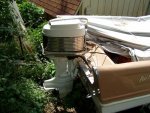threedeesmax
Petty Officer 2nd Class
- Joined
- Apr 15, 2005
- Messages
- 110
I worked on my 48-year-old Mercury Mark 58ae today. It hasn't been in running condition for many years, and I'm doing some of the standard things that need to be done to an old outboard to bring it back to life.
Don't try this without first purchasing the dreaded $50 service manual, because chances are high that you'll miss a thing or ten if you're not a veteran outboard mechanic - and I ain't one of them!
If you, on the other hand, have worked on this model, please feel free to offer advice, or tips that aren't included in the manual.
Here are some of my newbie-to-working-on-outboards observations. I used to be a hot-rodder (mostly 1972-1976 Vegas that I stuffed with nitrous-injected V8's), but this is totally different from car engines. Heck, I knew so little about outboards when I bought this one that I actually looked for an oil filter on the motor! LOL! I was also curious about the cam...another item that doesn't exist in an old 2-stroke outboard.
This motor is a 44-cubic inch 2-stroke that is rated at 45 horsepower. After I took the cowling off, I removed the starter, which has the solenoid bolted to it. There's not a lot of room, so it takes a bit of wrangling to get it out of its housing. It's a good thing that the starter works, because a replacement starter is a $300 item. The manual recoil starter will get a new spring and rope so I'll have a backup.
Then I removed the magneto, which comes off by removing four bolts - one of which is pretty difficult to reach.
After these parts were out of the way, I could reach the bolts on the two carburetors. They come off in one piece, connected to each other.
I sprayed the outside of the carburetor, starter, and the metal part of the magneto with brake cleaner. This cleans off all of the grease and oil and leaves a clean part with no residue.
I have to replace the timing belt, but I couldn't locate the right size socket. It can wait a couple of days.
Next is disassembling the carburetors, cleaning them, and installing carb kits. The starter and solenoid may get some fresh paint while they're off. I'll install a new set of points and a new condenser in the magneto, and I'll clean the fuel pump and install a kit in it - I'm sure the old diaphram is brittle. I'll also replace the motor's fuel hoses, and I'll replace the old wiring which is frayed and has most of its insulation worn off or eaten off by rodents. The water pump impeller will be replaced, too.
With luck, this facelift will get that old Mercury purring like a kitten.
Chime in, give me some tips and tricks please!
Don't try this without first purchasing the dreaded $50 service manual, because chances are high that you'll miss a thing or ten if you're not a veteran outboard mechanic - and I ain't one of them!
If you, on the other hand, have worked on this model, please feel free to offer advice, or tips that aren't included in the manual.
Here are some of my newbie-to-working-on-outboards observations. I used to be a hot-rodder (mostly 1972-1976 Vegas that I stuffed with nitrous-injected V8's), but this is totally different from car engines. Heck, I knew so little about outboards when I bought this one that I actually looked for an oil filter on the motor! LOL! I was also curious about the cam...another item that doesn't exist in an old 2-stroke outboard.
This motor is a 44-cubic inch 2-stroke that is rated at 45 horsepower. After I took the cowling off, I removed the starter, which has the solenoid bolted to it. There's not a lot of room, so it takes a bit of wrangling to get it out of its housing. It's a good thing that the starter works, because a replacement starter is a $300 item. The manual recoil starter will get a new spring and rope so I'll have a backup.
Then I removed the magneto, which comes off by removing four bolts - one of which is pretty difficult to reach.
After these parts were out of the way, I could reach the bolts on the two carburetors. They come off in one piece, connected to each other.
I sprayed the outside of the carburetor, starter, and the metal part of the magneto with brake cleaner. This cleans off all of the grease and oil and leaves a clean part with no residue.
I have to replace the timing belt, but I couldn't locate the right size socket. It can wait a couple of days.
Next is disassembling the carburetors, cleaning them, and installing carb kits. The starter and solenoid may get some fresh paint while they're off. I'll install a new set of points and a new condenser in the magneto, and I'll clean the fuel pump and install a kit in it - I'm sure the old diaphram is brittle. I'll also replace the motor's fuel hoses, and I'll replace the old wiring which is frayed and has most of its insulation worn off or eaten off by rodents. The water pump impeller will be replaced, too.
With luck, this facelift will get that old Mercury purring like a kitten.
Chime in, give me some tips and tricks please!




















